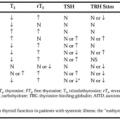ABNORMALITIES OF LABORATORY TESTS
Part of “CHAPTER 61 – RENAL OSTEODYSTROPHY“
One of the earliest changes in patients with chronic renal failure is increased plasma levels of PTH. As the disease progresses, hypocalcemia may occur. Although hyperphos-phatemia is not seen until the GFR is <25 mL per minute, one should remember that serum phosphorus remains normal as a consequence of the development of hyperparathyroidism, which occurs early in the course of renal insufficiency. The magnitude of the hyperphosphatemia depends on the amount of phosphorus ingested, the intestinal absorption, and the excretion of phosphorus by the diseased kidney. Hypermag-nesemia occurs with a GFR of <15 mL per minute; the administration of magnesium-containing antacids must be monitored closely. Serum alkaline phosphatase levels are often increased with osteitis fibrosa, osteomalacia, or mixed lesions. Metabolic acidosis commonly is present when the GFR is <25 mL per minute.52
ASSAYS FOR PARATHYROID HORMONE
Because hyperparathyroidism plays a major role in renal osteodystrophy, serum PTH must be measured to monitor the degree of hyperparathyroidism and the effects of treatment. Specific two-site immunoassays for intact PTH have become the most widely used and are readily available.53 The desired range for levels of intact PTH that are associated with normal bone turnover in patients with end-stage renal disease appears to be 150 to 300 pg/mL, or 2.5- to 5-fold greater than the upper limit of normal for the intact PTH assays; this higher range presumably represents the need for higher levels of the hormone to overcome the skeletal resistance to PTH discussed previously.54,55
Stay updated, free articles. Join our Telegram channel

Full access? Get Clinical Tree





